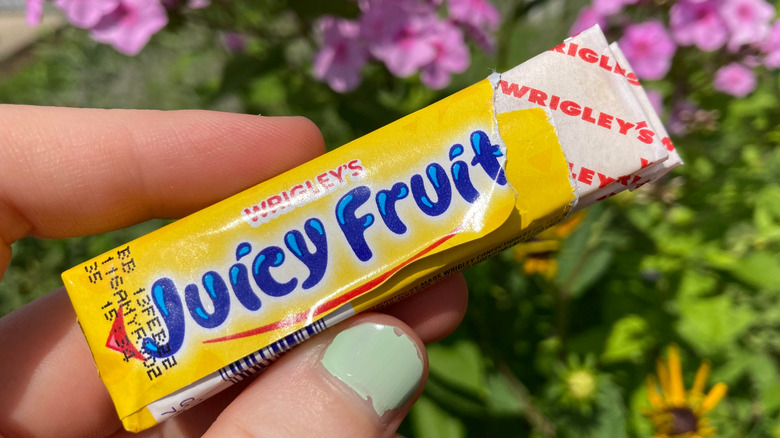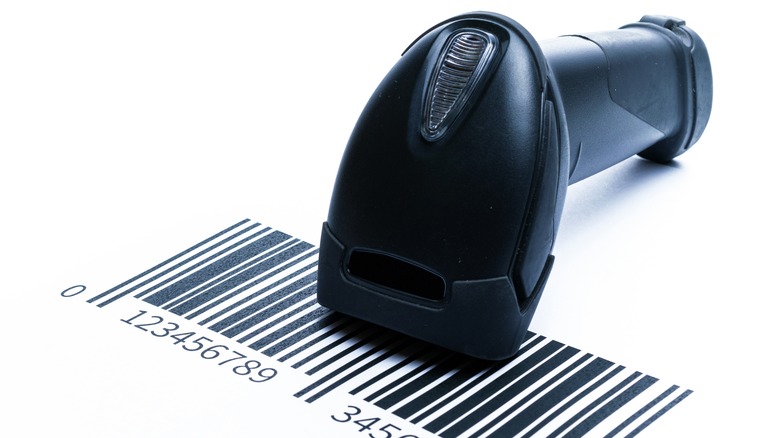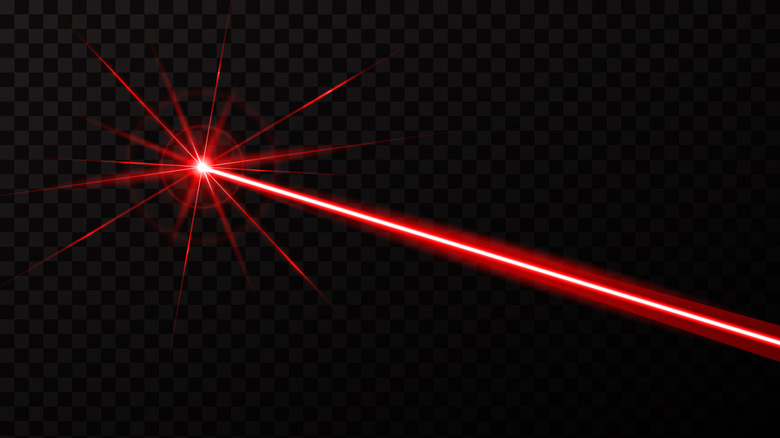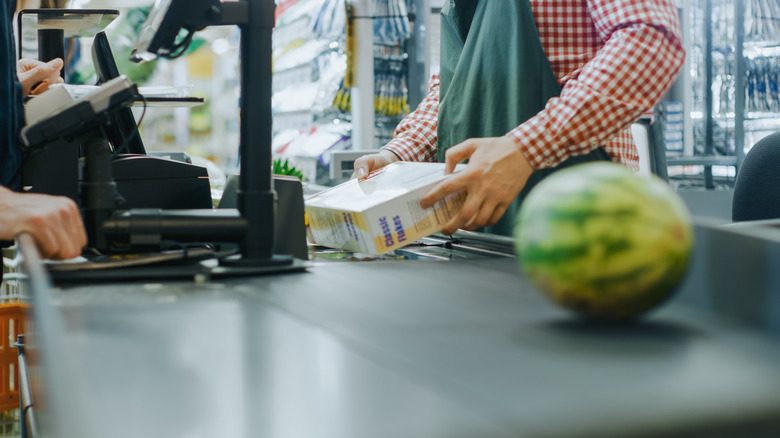Why The World's First Scanned Barcode Was On A Pack Of Gum
What do circles in the sand and science fiction-esque laser death rays have in common? They both served as inspiration for the innovation that forever changed the process of the grocery store checkout. The ubiquitous barcode scanner, a device we take for granted as we watch the supermarket cashier run items over a laser scanner to log our purchases (or do it ourselves at a self-checkout station), seems like it's been around forever, but it hasn't. In fact, the barcode and machine that scans them didn't come into wide use until the 1980s, and that was after nearly 30 years of research and development.
It all started in 1948 with a plea from a Philadelphia-based grocery store chain. Samuel Friedland, the president of Food Fair, was desperate for an innovation that would speed up the checkout process, so he approached leadership at the Drexel Institute of Technology (today known simply as Drexel University) to help him create the invention of his dreams. Unfortunately, the official response was lackluster, but it piqued the interest of graduate student and instructor, Bernard "Bob" Silver, who shared the idea with his colleague, Norman Woodland. Intrigued, the two set out to find a solution for Friedland's dilemma — and they did it within a year, but it wasn't until 25 years later, in 1974, that a multi-pack of Wrigley's Juicy Fruit chewing gum became the first-ever scanned grocery item.
It's all part of the plan
As reported by Smithsonian Magazine, the landmark scan took place on June 26, 1974 at the Marsh Supermarket in Troy, Ohio. And during the inaugural demonstration, Clyde Dawson, a Marsh Supermarket executive, reached into his shopping basket, pulled out the pack of gum, and handed it over to store cashier Sharon Buchanan. With the advantage of hindsight, it's a scenario we now know to be quite momentous, and we can almost picture it happening in slow motion, though for at least one person involved, it was anything but. (We'll come back to that.)
The fact that Wrigley's Juicy Fruit chewing gum was the item to herald a new age in grocery-store checkout wasn't happenstance. Dawson's choice of item, he later explained, was his way of showing his appreciation to the Wrigley brand for helping develop and print the scannable barcodes, which, of course, is an integral part of the technology as the machine scanners were quite useless without them. Many were dubious of the technology and Dawson wanted to stymie this by scanning an item many believed would be too small to get the barcode on. Wrigley, however, took up the task and shared glory with Dawson.
The development of the scanning machines, as it turned out, was quite the stumbling block.
So near and yet so far
Still wondering what circles in the sand and laser death rays have to do with grocery scanners? Well, Norman Woodland of the Drexel Institute took a sabbatical at his grandfather's place in Miami, partly to crack the puzzle of the scanners. One day, while sitting on the beach musing, he started doodling in the sand.
"The only code I knew of was Morse code," Woodland told Fortune in 2004 about the ah-ha moment he experienced while tracing symbols that resembled the code's dot-dash formula. "I had made four furrows. And I said, 'Wow. I can have encodation in the form of lines. I could have wide lines and narrow lines. Right?' And that was the invention of the barcode, right then and there." By 1952, Woodland and Silver had successfully fine-tuned and patented the code, but that's where their project stalled — for decades. While the barcode theory was solid, there wasn't yet an effective way to scan it, as lasers were unwieldy, computers were bulky, and both were expensive.
But in 1960, the Hughes Aircraft Company hosted a press conference to announce its invention of an "atomic radio light brighter than the center of the sun." They called it LASER, and The Los Angeles Herald likened it to a "science fiction death ray." Theodore Maiman, its inventor, foresaw myriad practical uses for the laser, but he certainly didn't expect it to change the supermarket industry.
The rest of the story
A few years later, a research team at RCA put two and two together when they discovered the patent Woodland and Silver had secured for their version of the barcode. The team tweaked the original design and came up with a system that worked. Committees got involved. Supermarkets, distributors, and manufacturers postured for position. Negotiations ensued, all leading up to that day — June 26, 1974 — at a supermarket in Troy, Ohio, when the invention 25 years in the making all came together as Clyde Dawson pulled out a pack of Juicy Fruit.
According to The New York Times, cashier Sharon Buchanan had no idea what was going on when she arrived for work that day. Unbeknownst to Buchanan, supermarket staff and a team from the National Cash Register had spent the previous night putting barcodes on grocery items and installing the scanning system. Everything was ready for the official demonstration. "I was a little bit nervous at the time," Buchanan recalled her surprise to the Times in 2009, saying, "I mean what if this doesn't work? Everybody was there taking pictures, the photographers, the local press, people from around town. But it worked just fine. It was quite my 15 minutes of fame, I suppose."



